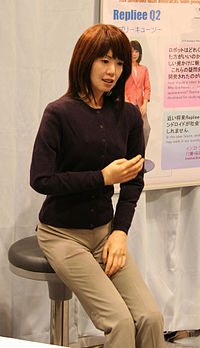
Photo from wikipedia
Background: In 1970, Mori hypothesised the existence of an ‘uncanny valley’, whereby stimuli falling short of being fully human are found to be creepy or eerie. Objectives: To investigate how… Click to show full abstract
Background: In 1970, Mori hypothesised the existence of an ‘uncanny valley’, whereby stimuli falling short of being fully human are found to be creepy or eerie. Objectives: To investigate how eerie people find different prosthetic hands and whether perceptions of eeriness can be accounted for by categorical ambiguity. Study design: Students participated in computerised experiments during which photographic images of hands were presented. Methods: We compared photographs of prosthetic hands pre-selected as more (H+) or less human-like (H–), as well as mechanical and real hands. Participants rated the hands for eeriness and human-likeness, as well as performing a speeded classification (human/non-human) and location judgment (control) task. Results: The H– prosthetic hands were rated as more eerie than the H+ prosthetic, mechanical and real hands, and this was unaffected by hand orientation. Participants were significantly slower to categorise the H+ prosthetic hands compared to the H– prosthetic and real hands, which was not due to generally slower responses to the H+ prosthetic hands (control task). Conclusion: People find prosthetic hands to be eerie, most consistently for less human-like prosthetic hands. This effect is not driven by ambiguity about whether to categorise the prosthetic hand as human or artificial. Clinical relevance More obviously artificial, less-realistic, prosthetic hands consistently generate a sense of eeriness, while more realistic prosthetic hands avoid the uncanny valley, at least on initial viewing. Thus, greater realism in prosthetic design may not always incur a cost, although the role of movement and cutaneous input requires further investigation.
Journal Title: Prosthetics and Orthotics International
Year Published: 2018
Link to full text (if available)
Share on Social Media: Sign Up to like & get
recommendations!